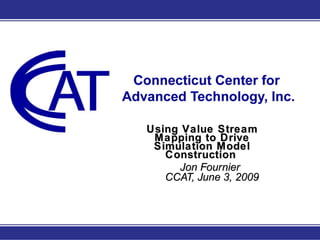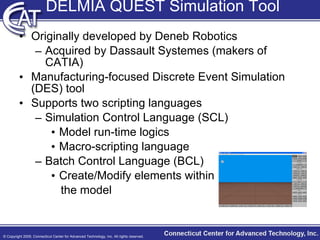IIE Applied Solutions 2009
- 1. Using Value Stream Mapping to Drive Simulation Model Construction Jon Fournier CCAT, June 3, 2009
- 2. The Connecticut Center for Advanced Technology (CCAT) works to strengthen technology-led competitiveness via collaboration with industry, government, and academia Strengthen existing companies Support a world class work force Lead innovation and enterprise creation CCAT
- 3. Helping to Strengthen our Nation Strengthening Economic Competitiveness Education Economic Development Technology Innovation Collaboration E-learning Project Based Interdisciplinary Multicultural
- 4. Laser Application Laboratory Experienced Staff State of the Art Equipment Focused on: Hole Drilling Marking Welding Machining Cutting Application Assessment In-Process Monitoring Laser Drilling Work Cell P50L Coupled to Work Cell Nutfield Laser Driller Various Workstations Lasertec DMG 80 Powerdrill Shape Kuka Robot IPG Photonics System Processing Fibers 10kW Yb:Glass Fiber Laser
- 5. Factory Simulation Modeling and Simulation Capabilities 3D Product Design/CAD Assembly Sequence Ergonomics Machining Optimization Inspection Value Stream Mapping Reverse Engineering Robotics Other Processes Composite Processes
- 6. DELMIA QUEST Simulation Tool Originally developed by Deneb Robotics Acquired by Dassault Systemes (makers of CATIA) Manufacturing-focused Discrete Event Simulation (DES) tool Supports two scripting languages Simulation Control Language (SCL) Model run-time logics Macro-scripting language Batch Control Language (BCL) Create/Modify elements within the model
- 7. Value Stream Mapping with eVSM Software developed by GumshoeKI Based in Microsoft Visio Utilizes Visual Basic for Applications (VBA) macros Export VSM data to Excel spreadsheet Calculate distance traveled with spaghetti charting eVSM.com
- 8. eVSM Data Import to QUEST Process list generated by eVSM Needs ŌĆ£next operationŌĆØ data to provide operation/assembly sequencing Save Excel output to plain-text file
- 9. eVSM->QUEST Model Builder ŌĆō Text Input User specifies configuration file for input data Identifies delimiter in text file Lists spreadsheet column names for data Lists SCL logic files to compile before building For assigning logics to buffers, machines Specifies model-wide settings Machine/buffer geometry/spacing Model init/term logic
- 10. eVSM->QUEST Model Builder ŌĆōElement Building Builds part classes Embeds process sequence in part class Builds machines with input/output buffers Makes connections between workstations Sets logics on machines, buffers Builds processes with requirements & products Identifies assembly operations and requires appropriate part classes
- 11. eVSM->QUEST Model Builder ŌĆō Optional Additions Adds QUEST constructs when data is found Labor requirements Setup/Changeover times Load/Unload times Process scrap MTBF/MTTR/%Uptime Source Arrivals Transfers unused data to process attributes Easily transfer data from VSM to QUEST for use in logics
- 12. eVSM/Visio Interface Automated export from eVSM, macro execution in QUEST Form for specifying model build parameters Builds BCL script to execute macro Starts QUEST in BCL mode, executes script
- 13. Spaghetti Charting for machine layout eVSM has basic ŌĆ£spaghetti chartingŌĆØ capabilities Generate Visio layout, connect processes Visualizes part travel CCAT developed spaghetti charting tools Creates ŌĆ£smartŌĆØ links between charts and VSMŌĆÖs Able to pull machine locations into VSM from layout QUEST importer uses these coordinates to locate machines
- 14. Demo
- 15. Electronic assembly modeling project Received processes in eVSM format Built initial importer for eVSM data Evaluated number of workstations, operators, and inspectors required to meet projected production rates
- 16. Machining cell evaluation Used spread sheet interface to import process data Evaluated number of stations, people, to meet projected production rates Evaluated proposed cell layout Identified bottleneck for machining time reduction
- 17. Machining Cell Evaluation Turbine Blade Manufacturing Cell Generated electronic Value Stream Map using eVSM TM Used eVSM to Generate QUEST model of system ŌĆ£ What IfŌĆØ scenarios were tested in the model ŌĆ£ CCAT has provided access to tools that have helped us better understand how to make our value stream lean. ┬ĀUsing their value stream mapping and factory modeling software, we were able to run ŌĆ£what ifŌĆØ scenarios on our future state. ┬ĀOur team was able to see the impact of batch sizes, buffer stock and asset utilization in a virtual environment before implementation.┬Ā This has given us the validation we needed to move forward on our shared resource value stream. I highly recommend any manufacturing company to tap into the CCATŌĆÖs state of the art offerings.ŌĆØ ~Continuous Improvement Manager for client
- 18. Large Fuel Cell Manufacturing Imported flow of parts from eVSM Manually modified element locations Manually added material handling system
- 19. Machining Value Stream Analysis Received data in eVSM format Modified map with simulation data Built spaghetti chart for machine locations Completely automated build (using BCL script)
- 20. Machining Bottleneck Identification Received basic VSM Evaluated future state recommendations Evaluated adding shifts to machine feeding bottleneck Evaluated splitting processes to different machines Total modeling and initial analysis time : 4 hrs
- 21. Conclusion Easy to generate basic QUEST models Eliminates much manual, tedious input to QUEST Works as a spreadsheet-based interface eVSM can quickly generate this spreadsheet format Looking at other simulation packages Basic exporter to FlexSim Basic exporter to Arena Working on exporter to NISTŌĆÖs Core Manufacturing Simulation Data (CMSD) format Package-independent
- 22. Looking for partner companies CCAT is looking for SMMŌĆÖs to use & test eVSM/QUEST tools Aerospace/DoD Supply Chain Level Companies
- 23. Questions? Jon Fournier Applications Engineer, CCAT 222 Pitkin Street, Suite 106 East Hartford, CT http://www.ccat.us [email_address] http://delmiaquest.blogspot.com
Editor's Notes
- #3: CCAT is a private non-profit organization that administers various state & federal programs including: SBIR, Manufacturing & Supply Chain Initiative, Hydrogen Energy Coalition
- #8: eVSMŌĆÖs tabular Excel output transforms a VSM from a strictly graphical representation of the manufacturing of a product line to a more easily used data format which is adequate for use in simulation, depending on the data stored in the VSM.
- #18: Completely automated build process through use of BCL scripting in addition to QUEST macro






















![Questions? Jon Fournier Applications Engineer, CCAT 222 Pitkin Street, Suite 106 East Hartford, CT http://www.ccat.us [email_address] http://delmiaquest.blogspot.com](https://image.slidesharecdn.com/jonfournieriieappliedsolutionsabstract56-1264015751895-phpapp02/85/IIE-Applied-Solutions-2009-23-320.jpg)